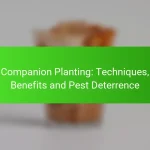Companion planting is a gardening technique that involves strategically pairing plants to enhance growth, deter pests, and improve overall garden health. In South Africa, this method can lead to increased crop yields, effective pest control, and a more resilient ecosystem. By understanding the unique benefits of compatible plant combinations, gardeners can cultivate healthier and more productive gardens.

What are the best companion planting techniques in South Africa?
The best companion planting techniques in South Africa include methods that enhance crop yields, improve pest resistance, and promote biodiversity. Utilizing these techniques can lead to healthier plants and more productive gardens.
Three Sisters method
The Three Sisters method involves planting corn, beans, and squash together, creating a mutually beneficial ecosystem. Corn provides a tall structure for beans to climb, while beans fix nitrogen in the soil, benefiting all three plants. Squash spreads out on the ground, blocking sunlight to suppress weeds.
To implement this method, plant corn first, followed by beans and squash a couple of weeks later. This staggered planting ensures that each plant supports the others effectively. Be mindful of spacing to allow each plant to thrive without overcrowding.
Intercropping
Intercropping is the practice of growing two or more crops in proximity for mutual benefits. This technique can enhance soil health, reduce pest populations, and optimize space. For example, pairing carrots with onions can deter pests that affect one another.
When intercropping, choose plants with different growth habits or nutrient needs to minimize competition. A common strategy is to plant fast-growing crops alongside slower ones, allowing for staggered harvests and maximizing yield from the same area.
Trap cropping
Trap cropping involves planting a specific crop to attract pests away from the main crops. This technique can significantly reduce pest damage by drawing insects to a less valuable plant. For instance, planting mustard as a trap crop can lure aphids away from more susceptible vegetables.
To effectively use trap cropping, select a plant that pests prefer and plant it around or within the main crop. Monitor the trap crop regularly to manage pest populations before they spread to your primary plants. Regular maintenance is crucial to ensure the trap crop remains effective.

How does companion planting benefit gardens in South Africa?
Companion planting offers numerous advantages for gardens in South Africa, including enhanced crop yields, effective pest control, and improved soil health. By strategically pairing plants, gardeners can create a more resilient and productive ecosystem.
Improved crop yield
Companion planting can significantly boost crop yields by optimizing plant growth conditions. Certain plants, when grown together, can enhance nutrient uptake and promote better pollination. For example, planting maize alongside beans can improve nitrogen levels in the soil, benefiting both crops.
To maximize yields, consider the growth habits of your plants. Taller plants can provide shade for shorter ones, while ground cover plants can suppress weeds, allowing main crops to thrive. Aim for combinations that complement each other’s growth cycles and resource needs.
Pest control
Companion planting serves as a natural pest deterrent by utilizing plants that repel harmful insects. For instance, marigolds are known to deter nematodes and aphids, making them excellent companions for vegetables. This method reduces the need for chemical pesticides, promoting a healthier garden environment.
When planning your garden, research which plants naturally repel pests that commonly affect your crops. Additionally, interplanting can confuse pests, making it harder for them to locate their preferred hosts. Regularly monitor your garden for pest activity to adjust your companion planting strategy as needed.
Soil health enhancement
Companion planting contributes to soil health by promoting biodiversity and improving soil structure. Deep-rooted plants can help break up compacted soil, allowing for better water infiltration and root growth. Leguminous plants, such as peas and beans, fix nitrogen in the soil, enriching it for subsequent crops.
To enhance soil health, rotate companion plants each season to prevent nutrient depletion and disease buildup. Incorporating cover crops during the off-season can also improve soil fertility and prevent erosion. Aim for a diverse planting strategy to maintain a balanced ecosystem in your garden.

Which plants are commonly used in companion planting?
Companion planting involves pairing specific plants together to enhance growth, deter pests, and improve overall garden health. Commonly used plants include marigolds, basil, tomatoes, beans, and corn, each offering unique benefits when grown alongside compatible species.
Marigolds for pest deterrence
Marigolds are widely recognized for their ability to deter pests, particularly nematodes and aphids. Their strong scent confuses and repels many harmful insects, making them an excellent companion for various vegetables.
When planting marigolds, consider placing them around the perimeter of your vegetable garden or interspersing them among your crops. This strategy not only protects your plants but also adds vibrant color to your garden.
Basil and tomatoes pairing
Basil and tomatoes are a classic companion planting duo, as basil enhances the flavor of tomatoes while also repelling pests like whiteflies and aphids. The two plants thrive in similar growing conditions, making them easy to cultivate together.
To maximize their benefits, plant basil close to tomato plants, ideally within a foot of each other. This proximity allows for better pollination and can lead to a more robust harvest.
Beans and corn synergy
Beans and corn create a beneficial relationship known as the “Three Sisters” method, where beans climb the corn stalks while fixing nitrogen in the soil, enriching it for both plants. This symbiotic relationship promotes healthy growth and maximizes space in the garden.
When planting, position corn first, allowing it to establish before adding beans. This timing ensures that the beans have a sturdy structure to climb, resulting in a productive and efficient garden layout.

How can companion planting deter pests effectively?
Companion planting can effectively deter pests by using specific plant combinations that repel unwanted insects or attract their natural predators. This method leverages the natural properties of plants to create a balanced ecosystem that minimizes pest problems in gardens.
Natural repellents
Many plants possess natural repellent properties that can keep pests at bay. For instance, marigolds are known to repel nematodes and aphids, while basil can deter flies and mosquitoes. Planting these alongside more vulnerable crops can create a protective barrier.
When selecting natural repellents, consider the specific pests you want to deter. For example, garlic and onion can repel a variety of insects, making them excellent companions for many vegetables. It’s essential to plant these repellent species in close proximity to the crops they are meant to protect for maximum effectiveness.
Attracting beneficial insects
Companion planting can also attract beneficial insects that prey on harmful pests. For example, planting dill or fennel can attract ladybugs and lacewings, which feed on aphids and other pests. This strategy enhances the natural pest control in your garden.
To optimize the attraction of beneficial insects, include a variety of flowering plants that bloom at different times throughout the growing season. This ensures a continuous food source for these helpful creatures. Additionally, avoid using broad-spectrum pesticides, as they can harm beneficial insects along with the pests.

What are the prerequisites for successful companion planting?
Successful companion planting requires an understanding of soil quality and plant compatibility. These factors significantly influence the growth and health of plants when grown together.
Soil quality assessment
Assessing soil quality is crucial for companion planting, as healthy soil supports robust plant growth. Key indicators include soil texture, pH level, and nutrient content. Aim for a pH between 6.0 and 7.0 for most vegetables, and consider conducting a soil test to determine nutrient levels.
Improving soil quality can involve adding organic matter, such as compost or well-rotted manure, which enhances soil structure and fertility. Regularly check for drainage and moisture retention, as these factors affect plant health and compatibility.
Understanding plant compatibility
Plant compatibility is essential in companion planting, as certain plants can enhance each other’s growth while others may compete for resources or attract pests. For example, tomatoes and basil are often paired together because basil can repel pests that affect tomatoes.
To determine compatibility, consider factors such as growth habits, nutrient needs, and pest resistance. A simple rule of thumb is to group plants with similar water and sunlight requirements to ensure they thrive together. Avoid planting species that are known to inhibit each other’s growth, such as onions and beans.

How to choose the right companion plants for your garden?
Choosing the right companion plants involves selecting species that benefit each other through pest deterrence, improved growth, or enhanced flavor. Consider factors such as plant compatibility, growth habits, and local climate to create a thriving garden ecosystem.
Climate considerations
Climate plays a crucial role in determining which companion plants will thrive together. Factors such as temperature, humidity, and rainfall patterns can influence plant health and productivity. For instance, warm-season crops like tomatoes and peppers may not perform well alongside cool-season plants like lettuce in regions with high summer temperatures.
When selecting companion plants, consider your local climate zone. Use resources like the USDA Plant Hardiness Zone Map to identify suitable plants for your area. For example, in Mediterranean climates, herbs like basil and oregano can flourish alongside tomatoes, while in cooler areas, pairing kale with garlic can yield better results.
Additionally, pay attention to microclimates within your garden. Areas with more sunlight or shade can affect plant growth. Grouping plants with similar light and moisture needs can enhance their growth and pest resistance, leading to a more productive garden overall.










